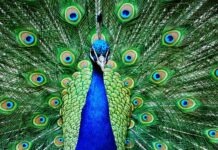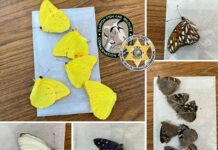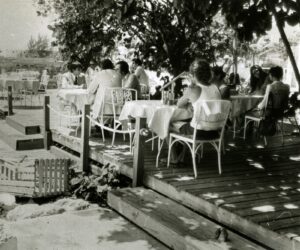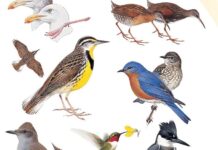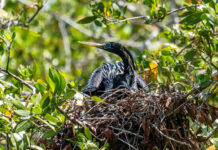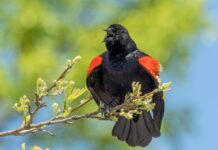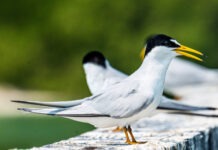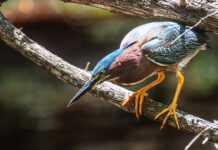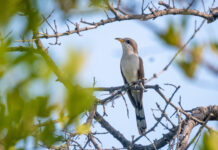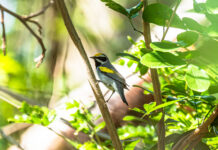The doves had been giving me the hairy eyeball all afternoon. Though with doves not having hair, I guess I should say they were giving me the feathery eyeball. But that doesn’t scan, poetic- meter-wise. So let’s say they were giving me the stink eye.
They were a mix of mourning doves and Eurasian collared-doves. One was sitting on the pole from which the feeder hangs. Two were on the high part of the fence, one or two were up in the mahogany branches, and one was up on the ridge peak at the gable end of the the roof.
I generally find birds to be non-emotive, and I feel a kinship with them over that. They’re like that guy who’s playing Jack Reacher now, only much smaller, with hollow bones and a total lack of ability to punch anybody. The similarity is that they show their character through their actions, and maybe a little body language. Here, they were all mostly just sitting there, staring at the bird feeder, passive, wanting me to refill it.
I generally have no problem keeping the feeder full, but we were about to have a good number of people over. I’d just gotten the deck all cleaned up, and doves are not exactly dainty eaters. They tend to smash their face down pretty hard, snatching up a bit of bird seed, sending other bits flying elsewhere and generally making a mess. Eventually, when the feeder is empty, they’ll get around to pecking up the spillage, but I didn’t have time for that. Also, they occasionally poop.
I wasn’t thinking much about the doves the next morning — until I looked out to the porch. There were more of them, and they were lower – perched on the table, the backs of chairs, the ground. Mostly they were just standing there again, watching the feeder, but occasionally they’d walk two or three feet closer or farther, heads bobbing with each step, perhaps trying to inspire some kind of action from the universe.
The thing about bird feeders is, birds are perfectly fine without them. They’re an easy meal, and everyone likes an easy meal, but birds existed for thousands of millennia without them, and would be perfectly fine if they all suddenly went away. Mourning doves and Eurasian collared-doves – the two species that had been hanging about – live almost exclusively on seeds from weeds, grasses and herbaceous plants, and the world is not running out of any of those. We put up feeders mostly to entertain ourselves, no matter how enthusiastic or guilt-inducing birds may get about them.
I suppose I could have refilled the feeders as soon as I saw the birds in the morning, but I was a little slow after such a festive evening and more focused on getting some work done. Also, I hate responding to guilt trips. And, I saw an opportunity. You don’t often get that many still birds all at once.
The doves seem to have developed a certain sense of trust over the years. They won’t hesitate to land on the feeder while you’re sitting there. Sometimes they’ll land on the ground near your feet and pretend you’re not there. And if moving with ermine-like stealthiness, you can slow step out onto the porch without having them flush. (The dog will sometimes follow when I try this, leaping onto the boards as loudly as possible for the sheer pleasure of seeing all the doves flush at the same time. But she was snoozing on the couch, more exhausted than anyone from the previous night’s socializing.)
All the birds froze when I came out, but they didn’t flush, and I made it to the Adirondack chair with my camera. I just sat for a while, waiting for them to stop noticing me. Then I started taking pictures, though I’m not totally sure why. I have a million pictures of mourning doves and Eurasian collared-doves, but when they’re willing to let you get that close, it is hard to resist.
Eurasian collared-doves are one of the more successful species on the planet. Native to India and China, about 100 years ago they started colonizing Western Europe as it became more and more developed. There are now thought to be 40 million to 75 million of them in Europe and Asia.
They reached the United States in the 1970s, when about 50 of them escaped from a captive population in the Bahamas and lammed it for Florida. Nine million of them are now thought to be in North America and the Caribbean.
But like many who are good at what they do, they are kind of boring, in both habits and looks – beige with a three-quarters collar low on their necks. And those are the distinctive parts. Nature’s minimalists. But I haven’t given up on someday deciding they are interesting looking.
Their feeding, staring cohorts, mourning doves, are native to North America, and it was thought the expanding Eurasian collared-dove population might hurt them, but it hasn’t happened, not as of yet.
Some believe the collared-doves eat larger seeds than the mournings, thus reducing the need for competition.
Mourning doves are successful in their own right, having expanded their population to an estimated 350 million, containing themselves largely to North America and the Greater Antilles.
At first glance, they are not much more interesting than the collared-doves – a kind of tobacco brown with a slightly encephalitic-looking skull and a tiny bill. But they grow more complicated the more you look at them.
The tiny bill looks all black at first, until you notice it turns a kind of dusky rose at the gape – where the harder pectin of the bill transitions to the softer skin. The plain dark eye is surrounded by the thinnest Oslo blue eye ring. The uniform brown of their counter and head feathers becomes a series of constantly shifting subtle color zones – opium brown becoming a whiskey umber becoming a sort of pinkish tumbleweed faun.
Their tail is longish and pointed like a dagger, and when they fly it shows a kind of lacy-looking edge up near the body. There’s a black spot just under the ear that seems to call back to the black spots on their secondaries.
Of course the stillness on that deck couldn’t last forever. A Cooper’s hawk landed in the mahogany; they all leaped up and scattered. The Coop made a half-hearted chase, but I don’t think he caught any of them.
I refilled the feeder after they were all gone, knowing they’d be back in a couple hours.







